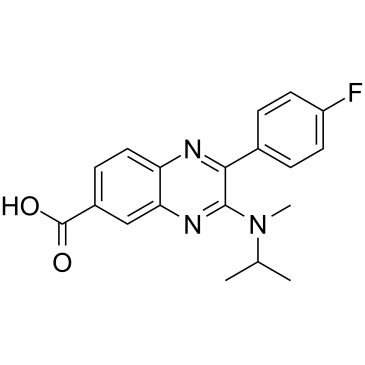| Cas No.: | 1268863-35-9 |
| Chemical Name: | BioE-1115 |
| SMILES: | O=C(O)C1C=C2C(N=C(C(=N2)N(C(C)C)C)C2C=CC(F)=CC=2)=CC=1 |
| Formula: | C19H18FN3O2 |
| M.Wt: | 339.36 |
| Purity: | >98% |
| Sotrage: | 2 years -20°C Powder, 2 weeks 4°C in DMSO, 6 months -80°C in DMSO |
| Publication: | [1]. Wu X, et al. PAS kinase drives lipogenesis through SREBP-1 maturation. Cell Rep. 2014 Jul 10;8(1):242-55. |
| Description: | BioE-1115 is a highly selective and potent PAS kinase (PASK) inhibitor with an IC50 of ~4 nM. BioE-1115 is also a potent casein kinase 2α inhibitor with an IC50 of ~10 μM[1]. |
| Target: | CK2α:10 μM (IC50) |
| In Vivo: | BioE-1115 (1-100 mg/kg; oral gavage; daily; for 7 days; male Sprague-Dawley rats) treatment shows a dose-dependent suppression of the expression of Gpat1, Fasn and all other SREBP-1c target genes analyzed. SREBP-1 maturation in liver is also suppressed in BioE-1115 treated rats at 10, 30 and 100 mg/kg doses. A calculated measure of insulin resistance, HOMA-IR, is decreased in a dose-dependent manner by BioE-1115 administration. Hepatic and serum TAG are decreased in a dose-dependent manner by BioE-1115 administration. BioE-1115 treatment causes a significant decrease in serum glucose. Both SREBP-1c and SREBP-1a mRNA are modestly decreased at the highest doses. Neither dose of BioE-1115 causes a significant change in either liver weight or body weight[1]. Animal Model: Male Sprague-Dawley rats (12 weeks of age; 129.4 ± 0.63 g) fed with high fructose diet[1] Dosage: 1 mg/kg, 3 mg/kg, 10 mg/kg, 30 mg/kg and 100 mg/kg Administration: Oral gavage; daily; for 7 days Result: Treated with 10, 30 and 100 mg/kg, showed a dose-dependent suppression of the expression of Gpat1, Fasn and all other SREBP-1c target genes analyzed. Decreased hepatic expression of lipogenic SREBP-1c target genes, decreased serum triglycerides and partially reversed insulin resistance. |
| In Vitro: | In the presence of BioE-1115, shows a dose-dependent loss of PASK phosphorylation, with an IC50 of ~1μM in HEK293 cells[1]. At the concentrations above 10μM, BioE-1115 treatment shows a significant reduction in SREBP activity, without any observable effects on cell morphology or growth rate in HepG2 cells[1]. |
| References: | [1]. Wu X, et al. PAS kinase drives lipogenesis through SREBP-1 maturation. Cell Rep. 2014 Jul 10;8(1):242-55. |

 To enhance service speed and avoid tariff delays, we've opened a US warehouse. All US orders ship directly from our US facility.
To enhance service speed and avoid tariff delays, we've opened a US warehouse. All US orders ship directly from our US facility.




















